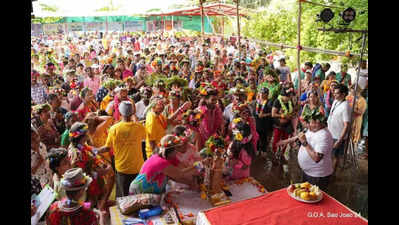Mumbai takes a leap of faith: Festival of San Joao makes a splash in city | Mumbai News – Times of India

Mumbai: The star of a Catholic saint has been on the rise in Mumbai, reaching its zenith every year on June 24, the day of his feast, San Joao. St John the Baptist (San Joao in Portuguese) was the cousin of Jesus, who baptised him in the River Jordan and initiated him into his ministry. Over the years, the feast in Mumbai has evolved from a neighbourhood community festival to a citywide carnival, with events hosted from Marine Lines to Manori, open to people within and outside the Catholic fold. Its widespread appeal is due in part to the unique customs and revelry that frame it, celebrating not just the saint, but nature, the rains, and, curiously, newlyweds alongside.New son-in-law dayIn East Indian and Goan tradition, a married couple visits the bride’s home, where the son-in-law is feted and fed. In Uttan, fireworks welcome a couple into the village a day prior to the feast, which is also called ‘Jaavaycha Sann’ or New Son-in-Law Day. “When they arrive, the groom unearths the ceremonial coin buried under the ‘arka’ for good luck,” says Mogan Rodrigues, co-founder of Sangath, a Bombay East Indian cultural platform. “On the day of the feast itself, the couple attends mass in the morning. In the evening, they are led by an East Indian brass band in a lively procession to the village well, where their feet are washed by women from the family or the community. Singing and dancing, everyone returns to the bride’s house for light refreshments, while later, a more elaborate dinner of pork Indyal, stuffed chicken and mutton stew is laid out for the son-in-law,” he says.Gleason Barretto, a coordinator with the Mobai Gaothan Panchayat (MGP), believes East Indians wash the couple’s feet as a sign of respect and acceptance for the new son-in-law, and says the sacrament of baptism, signifying ritual cleansing and a new beginning, may have been extrapolated to the matrimonial context. Goans don’t practise this custom.Water worksWater is central to San Joao celebrations, recalling St John’s baptism. In Mumbai and Thane, wells, ponds and tanks stand in for the river, with community members leaping into wells. If a waterbody isn’t available, tankers are summoned and sprinklers set up. There was a time, though, when the mechanics were more rudimentary. “We’d empty buckets of water from the terrace or hose each other with pipes,” laughs Wency Pereira of Goan Outreach Association. “Goans who had no access to wells celebrated San Joao in building compounds. But as the numbers grew, we needed a larger venue.” In places where wells vanished, pools both tiled and inflatable, became the new proxy. “We rented a BMC pool one year,” recalls Fleur D’Souza, former history department head at St Xavier’s College and a parishioner of St John the Baptist Church, Thane. “Festivities began a whole week prior with tournaments and games. It was the first big celebration after Easter.”New currentsIn the past decade, San Joao celebrations have moved beyond homes and gaothans into gymkhanas, clubs and resorts, especially in Gorai and Manori. “It wasn’t this popular a couple of years ago,” notes Pereira. “We had close to 1,000 people at our event last year.” The festival is now marketed as a semi-carnival with live bands, competitions, rain dances and pool plunges. Traditions are observed, but with a twist. At Felix Sequeira’s San Joao party in Gorai, prayers led by a priest are followed by the ceremonial plunge—led by brides.While most events are promoted via WhatsApp and word of mouth, some, like Mumbai Meri Jaan Foundation, use ticketing platforms. “Last year, we had 1,700 people; this year we expect 2,500,” says Nicholas D’Souza, manager at the foundation.Purists though believe such events dilute tradition. For organisations like MGP, the sanctity of the festival is rooted in community and custom. Its revivalist manifesto, San Jao Cha Sann!, encourages celebration at local water bodies and restoration of neglected wells. “Reviving cultural traditions around water bodies can help revive the waterbodies themselves,” says Alphi D’Souza, MGP’s global head. Rising to the task, the East Indian community in Vakola will organise its first San Joao at the gaothan well on June 24.















